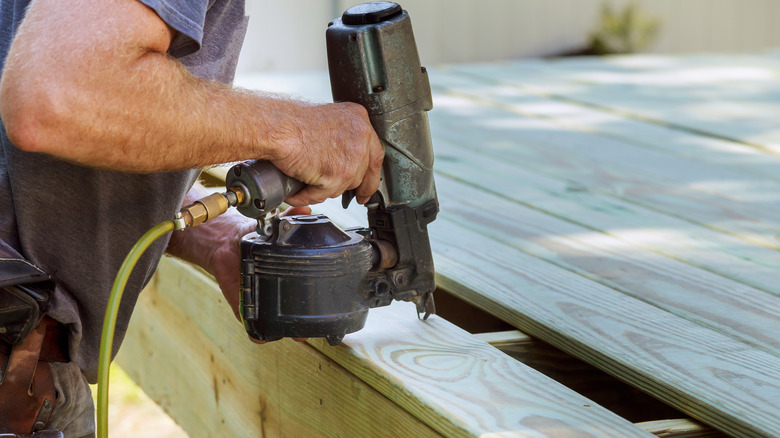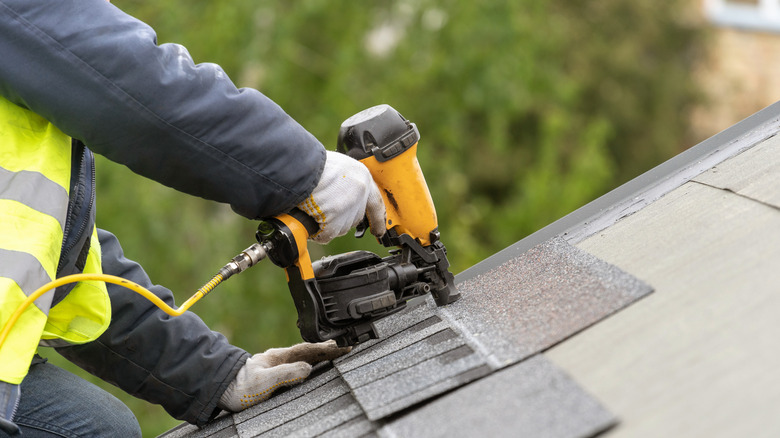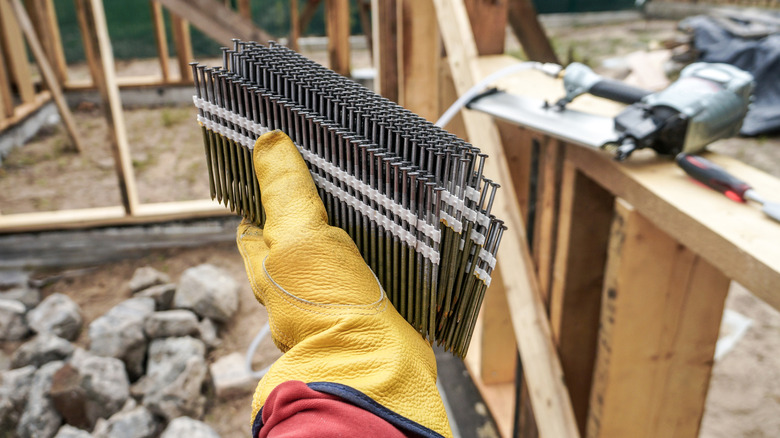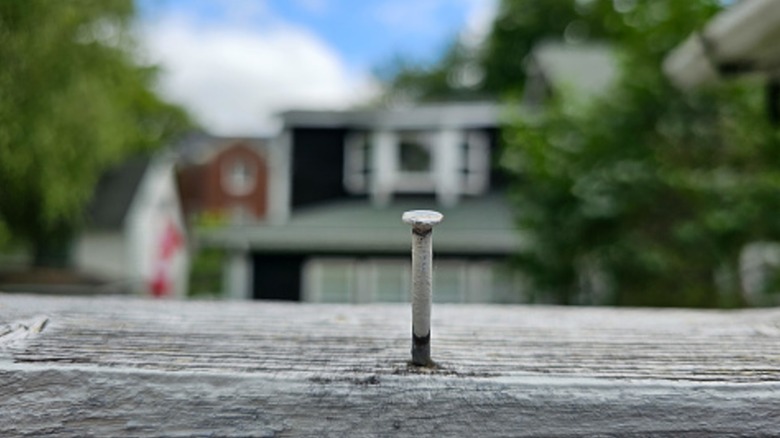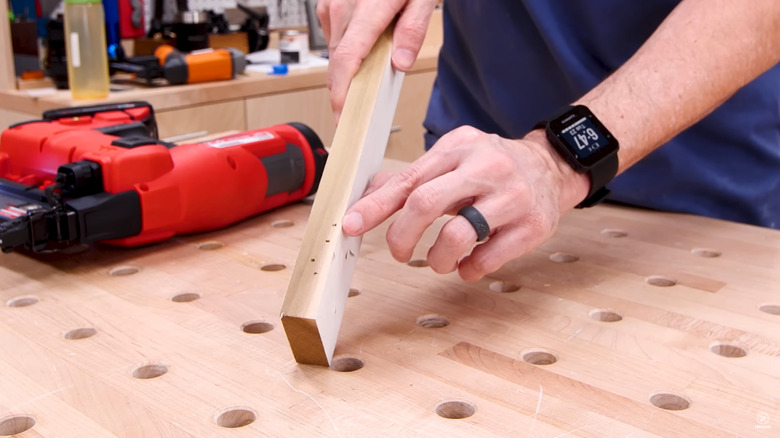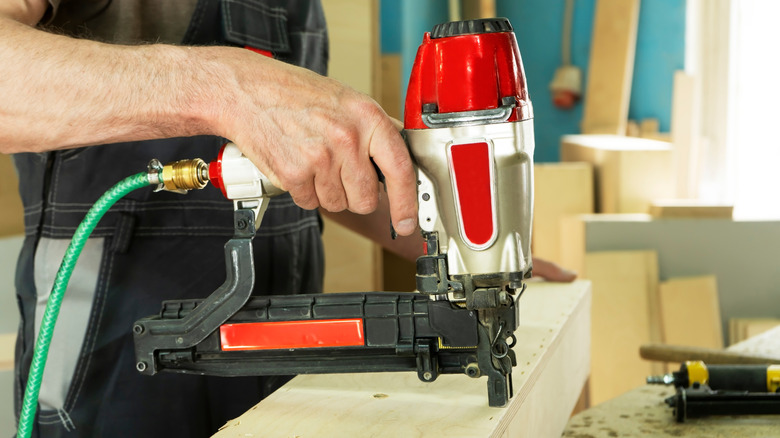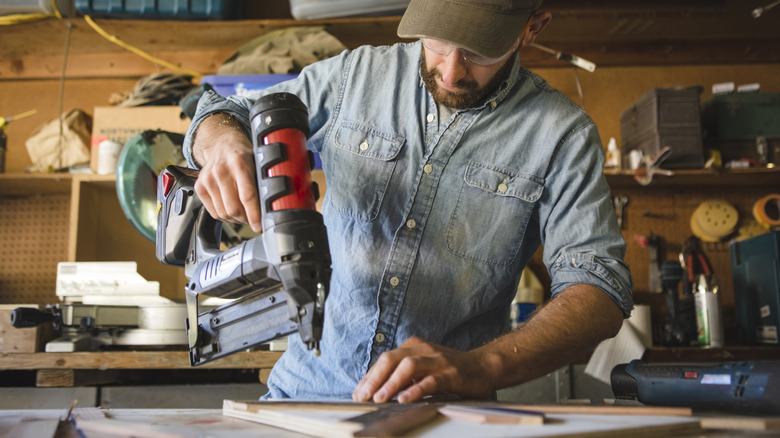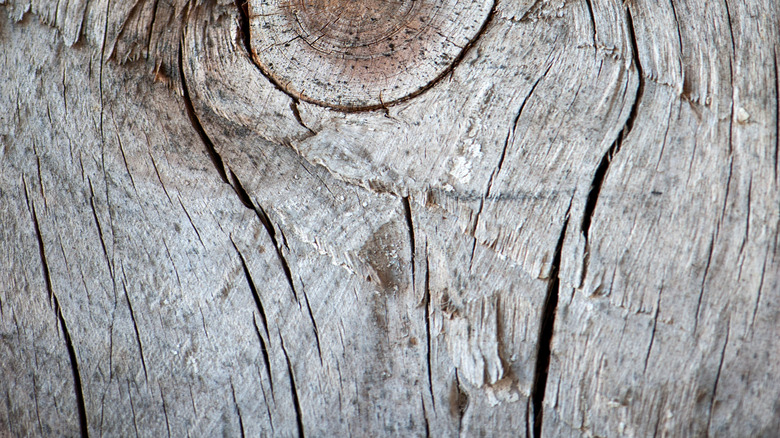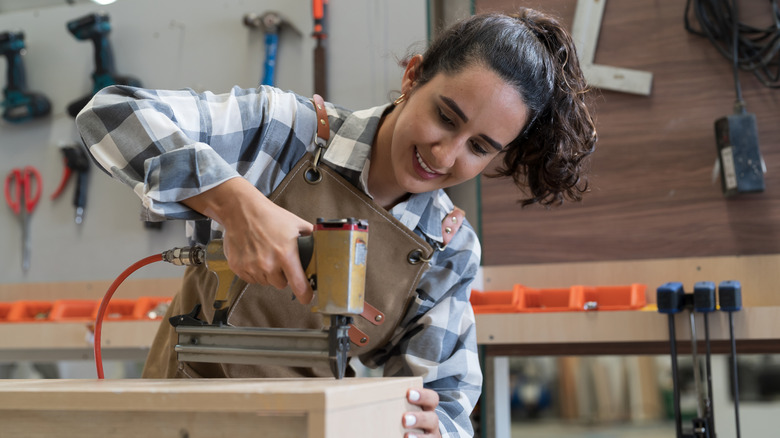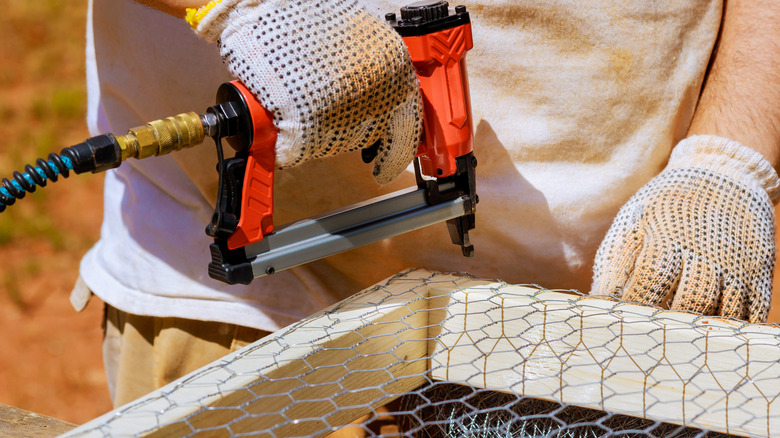9 Common Nail Gun Mistakes That Could Cost You
We may receive a commission on purchases made from links.
Nail guns are one of the tools worth investing in if you want to start woodworking or tackle some home improvement tasks. They offer several benefits over relying on using a hammer to drive in every single nail for a project. Not only can you place the nails in faster, but the results are also much more accurate. Nails are driven in with the same amount of force and don't get bent due to swinging the hammer at a slightly incorrect angle.
However, while a nail gun can be a real asset for several project types, there are a few mistakes you'll want to be careful to avoid when using (or choosing) one. Depending on the circumstances, some of these mistakes could result in a damaged or structurally unsound finished product. Other mistakes could pose a serious risk to your safety or the safety of others who are working around you. Ahead, we'll take a look at some of the most common nail gun mistakes and share what you should do instead to keep yourself safe and ensure your home improvement project turns out as planned.
Not choosing the right type of nail gun for the job
A nail gun is a nail gun is a nail gun, right? Not so fast, there are actually different types of nail guns, and choosing the wrong one for your project could prove to be a mistake. You need to consider the motor type. Electric nail guns, particularly cordless models, are easily portable. However, depending on the demands of the job you're working on, these nailers may not offer sufficient power.
For a more powerful option, you can consider a nail gun with a brushless motor. These nailers feature a system of magnets with an electronic circuit connecting the components and powering the tool. Unlike brushed motor guns, there's no friction. This means that the tools operate more efficiently, while also being more responsive and efficient.
When buying a nail gun, you may also want to consider a pneumatic gun. Also called air nail guns, these models are powered by compressed air. The compressed air delivers increased power. However, with these models you'll also need an air compressor, and you'll be tethered to the compressor with the air hose. This can make them more difficult to move between locations or to get into tighter spaces.
Not choosing the right gauge and nail size for the material you're working with
Beyond the different motor types, there are also different nail sizes. This nail gauge should also be closely considered before starting a project. Not only do you need to buy the correct size nail for the job, but you'll need to use them with a compatible nail gun. Despite what you might guess, a larger nail gauge actually indicates a smaller nail. An 18-gauge nail, for example, will be smaller than a 15-gauge nail. While the thickness and length of a 15-gauge nail would be ideal for securing thicker trim for a project, an 18-gauge nail would be a better choice for finer detailing tasks.
Unless you're a serious woodworker who needs to have a variety of nail guns at your disposal, you're probably only looking to invest in one product that will help you accomplish a variety of tasks. If this is the case, then your best choice is to purchase a 16-gauge nail gun and nails. This is considered the most versatile size and can be used with nails that are between ¾ and 2 ½ inches long. You can use a 16-gauge nail gun for tasks such as installing baseboards, door jambs, trim, and more. Don't forget to also make sure that the nail you choose is the ideal length for the project you are working on. The nail must be long enough to securely attach the two components together, but not too long that it will stick out of one end or cause damage to bordering materials.
Under- or over-driving the nail
Under- or over-driving nails are two other mistakes that people often make when using a nail gun. Both can create their own sets of problems. An over-driven nail will penetrate too deeply into the material, leaving a larger hole to fill. If you're working with a particularly thin piece of wood, an over-driven nail may also make it more likely that the upper piece of wood will simply snap off, as the nail is too deep and not actually holding the entire piece. Under-driven nails are also not good. Their head won't fully penetrate the surface of the upper material. Instead, they'll stick up a bit, leaving the potential for injuries, snags, or other problems if you don't finish driving them in by hand.
To avoid under- or over-driving a nail, it is essential to pay attention to the settings on your nail gun and the compressor, if you're using a pneumatic model. Most nail guns feature an adjuster knob. You can turn this knob to adjust the driver to match the needs of the material you're working with. If you have a pneumatic nail gun, you should look at the small writing along its base to find the PSI range recommended by the manufacturer. Keep your compressor within this range, but consider the project you're working on to determine the precise setting. The lower the PSI, the weaker the force will be. For thicker or harder materials, this could leave you with an under-driven nail. A higher PSI indicates a stronger force, which would be necessary for thicker, denser materials, but could be overkill for thinner pieces of wood.
Blowing the nail out of the side of the material you're working with
No one wants to make the mistake of blowing a nail out of the side of the material they're working with. This has the potential to damage — or even ruin — a project. However, many people continue making this same mistake simply because they don't fully understand why it is happening and what they should do differently to prevent it.
There are a few reasons nails are likely to blow out the side of a surface. First, if you look at the grain of the material you're working with, you might notice that it is slanted. The nails want to follow the grain, so they may get directed in that same angle, sending them out the side. The position and angle of the gun itself plays a very important role as well. If you place it right up to the edge, you're increasing the chances that the nail will blow out. Similarly, if you start with the gun at an angle, you'll end up shooting the nail at the same angle, sending it through the board and out the edge.
To avoid these blowouts, make sure you position the nail gun towards the center of the material you are fastening. Before firing, confirm that it is straight. Another tip that can help prevent the nail from blowing out is to hold the nailer perpendicular — not parallel — to the material you're working with. As you shoot nails, they may bend left or right. If you're working with the gun perpendicular to the material you're working with, if they do bend, they'll still stay within it.
Not pairing the right air compressor with your nail gun
If you have a pneumatic air gun, you won't be able to operate it without a compressor. The first thing to do is to consider the PSI requirements of each tool you'll be using, along with how quickly you'll be working with it. A compressor with a high CFM will keep larger and more powerful nail guns running for longer without the need to pause for a charge. However, these compressor models will be larger and more difficult to move. They'll also be louder, so they might not be the right pick for your home.
If you only need the nail gun for smaller projects or want to work without disturbing anyone in your home, then a more portable and budget-friendly air compressor might be the best way to go. Such a model should be sufficient for a variety of projects for the average homeowner, as even a 1 horsepower unit with a 2.0 CFM rate can allow around 15 nail drives every minute for a larger nail gun, or around 70 drives per minute for a smaller brad nailer.
Not keeping your fingers and other body parts away from the path of the nail
When you're working with a nail gun to secure materials together, there are a lot of things to keep track of. You need to make sure that you have the materials lined up correctly and ensure that the nail gun is in the right position and at the right angle. As you're thinking about all of these important aspects, it is easy to overlook your own safety. However, you must also be very cognizant of where your fingers and the rest of your body are located as you work.
If you leave your fingers or another body part in the path of the nail, you are asking for trouble. If the nail blows out, or the nail gun slips, you could end up puncturing your skin with a sharp nail traveling very quickly. You can imagine the pain and potential injury that could result. Instead, you must be very careful when you're working with a nail gun. Always keep your hands a minimum of 1 foot away from where the nail is being driven into. If you feel the need to use your hands to keep two materials together before nailing, try using a clamp instead.
Failing to examine the surface before driving nails
Another of the top woodworking safety precautions to practice when using a nail gun is thoroughly inspecting the materials you're nailing together. While it may be tempting to get right to work, you shouldn't rush into this step. Instead, take some time to look for any knots or existing metal framing in the materials you want to nail together. If any of these are present in the wood, you'll need to be very careful to avoid driving nails into those areas.
The problem with knots or metal in a wooden object is that they have the potential to cause a nail to ricochet. Ricocheting refers to when the nail hits these surfaces and then bounces back off because it is unable to penetrate them. And, when you think about how quickly nails shoot out of a nail gun, you can get an idea of how quickly the nail could bounce back off the item and the disastrous damage or injury that could result from the ricochet. This is a problem that can be avoided by checking out the materials before you work and taking a little extra time to make sure you are properly positioning the nailer.
Working without personal protective equipment
There are several key safety tips that every beginner woodworker should follow. One of these — that really applies to everyone working with a nail gun — is to wear protective gear. Failing to properly protect yourself only increases the chance of any injury. For example, if you're wearing hard-toed shoes, a stray nail won't be able to penetrate your foot. Conversely, if you're just wearing a pair of sandals — or even working barefooted around the house — that same stray nail could spell big trouble.
In addition to an appropriate pair of shoes, you should always wear a pair of high-impact safety glasses or goggles, such as the DeWalt Concealer Safety Goggles. It is also a good idea to protect your head with a hard hat and wear a pair of earplugs, such as the Mack's Foam Earplugs, or ear muffs, like the 3M Pro-Grade Earmuffs, to protect your ears from the loud sounds that a nail gun and compressor make.
Not knowing when it is safest to use a hammer instead of the nail gun
Nail guns are often a better option than using a hammer to drive a nail in by hand. They're much faster and can often eliminate irregularities or bent nails. However, that doesn't mean that you should always choose a nail gun over a hammer. There will be times when a hammer is the better — and safer — tool for the job, and it is important to be able to identify these situations.
If you ever need to drive a nail into lumber that has metal framing hardware on it, lots of knots, or other irregularities, your safest bet is usually to reach for a hammer. Remember, if you shoot a nail into these harder materials using a nailer, it may ricochet back and hit something. And, that something could be you or another person who is close by. Other times when it is best to use a hammer include if you're working at a very awkward angle where you won't be able to hold the nail gun properly or won't be able to hold it with your dominant hand. Here's how to choose the perfect hammer for the job to ensure success.
